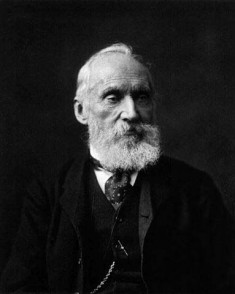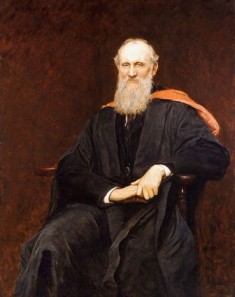| Lord Kelvin | |
|---|---|
 |
|
| Physicist | |
| Specialty | Math, physics |
| Born | June 26, 1824 Belfast, Ireland, UK |
| Died | Dec. 17, 1907 (at age 83) |
| Nationality | Largs, Scotland, UK |
William Kelvin was a British mathematical physicist and engineer. He did important work in mathematical analysis of electricity and even formulated the first and second laws of thermodynamics. William also worked as an electric telegraph engineer and inventor which propelled him into the public eye and ensured his fame, wealth, and honor. He was knighted by Queen Victoria to become Sir William. Lord Kelvin is famous for determining the accurate value of absolute zero as approximately -273.15 Celsius.
Early Life
William was born on June 26, 1824. His father was a teacher of mathematics and engineering. At the age of nine, William had heart problems that almost killed him. He attended the Royal Belfast Academical Institution where his father was a professor. In 1834, at the age of 10, he started his studies at Glasgow University. The university provided many facilities of an elementary school for the able pupils and was basically a typical starting age.
In this school, he showed great interest in the classics and sciences. At only 12 years old, he won a prize for translating a book from the Latin language to English. Between 1839 and 1840, William won the class prize in astronomy in an essay. In this essay, he showed great talents in mathematical analysis and creativity.
Time at Cambridge
In 1845, William graduated as Second Wrangler. He also won a Smith’s Prize which was test of original research. While still at Cambridge, he was active in sports and sculling. He even won the Colquhoun Sculls in 1843. He was also interested in music, classics, and literature. However, his real love was science. In 1845, he gave his very first mathematical development of Faraday’s idea. The idea said that electric induction only takes place through intervening medium or dielectric action at distance.
Kelvin was also able to devise a hypothesis of electrical images; this became a very powerful agent in solving different problems of electrostatics. With the help of William, Faraday undertook his research and in 1845, he discovered the Faraday Effect. This effect established that magnetic phenomena and light were related. In June of 1845, he was elected fellow of St. Peter’s. He spent some time in the lab of Henri Regnault in Paris. In 1846, he was appointed chair of natural philosophy at the University of Glasgow.
Kelvin’s Career Highlights
 At the university, Kelvin introduced some laboratory work in the degree courses. William was greatly interested in improvement of the physical instrumentation; he implemented many devices such as mirror-galvanometer that was actually used in the very first successful sustained telegraph transmissions in a transatlantic submarine cable.
At the university, Kelvin introduced some laboratory work in the degree courses. William was greatly interested in improvement of the physical instrumentation; he implemented many devices such as mirror-galvanometer that was actually used in the very first successful sustained telegraph transmissions in a transatlantic submarine cable.
Due to his great works on the first transatlantic cable, he was knighted and named Lord Kelvin. He joined a team of industrialists working on a project to lay submarine cable between Newfoundland and Ireland. William played several important roles in the project since he was on the board of the directors and also an advisor of electrical matters.
Lord Kelvin helped in developing the second law of thermodynamics. Thermodynamics was basically an explanation of irreversible processes. He noted that if entropy increased, the universe would at one point reach a state of uniform temperature plus maximum entropy; this would make it possible to extract any form of work. He named this Heat Death of Universe.
Thermodynamical Theory
After this, he proposed the thermodynamical theory. The theory was based on a dominance of energy concept that believed all physics should be based. By the year 1847, William had gained a very good reputation as a great scientist. In 1848, he provided an operational definition of temperature.
He proposed an absolute temperature scale; it had a unit of heat descending from one body to another. The unit heat would give the same mechanical effect, whatever the number. Basically, this scale would be independent of physical properties of any specific substance.
Later Life
Lord Kelvin was also a yachtsman; he was greatly interested in sea-related sports. He even introduced a certain method of deep-sea sounding. In this method, a steel piano wire replaced the ordinary land line. This wire glides very easily to the bottom. He also added a pressure gauge to register the real depth of the sinker. Throughout his life, he won many honorary degrees for his great work and ranked among the most popular scientists in history. He passed away on December 17, 1907, in Scotland.